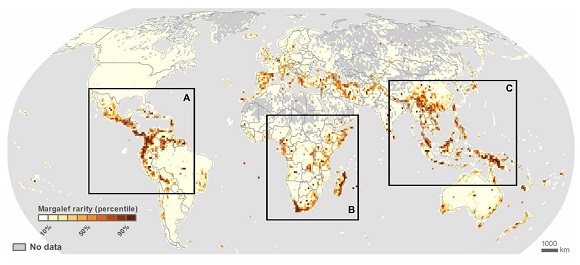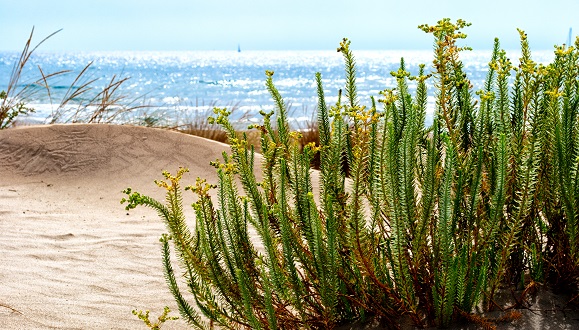The hidden side of rarity: it's not that rare being rare
Begoña García has spent many years passionately studying a curious plant, Borderea chouardii. It is a rare species with a biogeographical origin that dates back to the Tertiary and remains confined to a few limestone cliffs in the Central Pyrenees. Unknown until the middle of the 20th century, it is considered an endangered species. But... is it?
![]()
For Begoña, Adrian and Fernando
Concerned about its fate, Begoña has explored their populations in detail: she has looked for new individuals among the cracks in the cliffs, she has labeled the plants that grow every year from small tubers hidden among the rock, she has counted their flowers and seeds and identified the ants as those responsible for the pollination of its flowers and the dispersal of its seeds to new cracks. Thanks to these censuses, she has been able to estimate whether the populations of Borderea chouardii are in decline.
How vulnerable are these species, usually included in lists or red lists of species to be protected? How are so many rare species able to persist over time?
The surprise has been great after verifying that, if things continue the same, the future of these populations is assured for the coming centuries, despite the fact that the number of new plants is low. This is so thanks to the long life of the tubers (more than 300 years), which produce new stems year after year. It is not the only case in which the detailed study of the demography of rare species has found that, despite their rarity, their populations are not in decline. This raises several interesting questions: how vulnerable are these species, usually included in lists or red lists of species to be protected? How are so many rare species able to persist over time?
In 1981, ecologist Deborah Rabinowitz proposed three criteria to determine the rarity of species. The first criterion is to live in a restricted area. The endemic species, which are only found in defined geographical areas, would fulfil this criterion, particularly if they are small areas. Island endemism, so abundant in the many islands, would be a good example. The second criterion is that they live in very specific, rare habitats. Quite a few species that live exclusively on rocky walls, such as those that accompany Borderea chouardii would meet this criterion. The third criterion is that these are species with small populations, with few individuals. This is the case of Astragalus nitidiflorus, an herbaceous legume from the southeast of the Iberian Peninsula that was considered extinct, and from which a few individuals were rediscovered in 2004. Not by chance, these criteria can occur simultaneously, increasing the degree of rarity, as is the case of Borderea chouardii, regarding its restricted distribution area and habitat.

Any species that lives in one place has Damocles' sword on it, since any disturbance that destroys that place takes their populations ahead.
These rarity criteria are a useful tool for establishing categories and priorities for conservation. Any species that lives in one place has Damocles' sword on it, since any disturbance that destroys that place takes their populations ahead. Something similar occurs when a systemic alteration of the environment, such as climate change, endangers a habitat, and therefore those species that live exclusively in it. It is the well-known case of polar fauna. Finally, species with few individuals are subjected to problems of consanguinity and genetic diversity, and also to any contingency that makes their populations disappear completely or reduces them to levels where reproduction is not viable.
However, demographic studies show us that the demographic dynamics of many rare species is not so different from that of more common species. So, the rarity criteria proposed by Rabonowitz do not necessarily imply a demographic collapse. This has important consequences for conservation. On the one hand, because it warns that some species that may not yet have very apparent signs of rarity may be experiencing a demographic decline. But more importantly, because it provides us with powerful tools to focus our efforts on those species that are really endangered and to implement actions that improve the state of their populations, once we know their demographic weak points (reproduction, dispersal and bank of seeds, germination, mortality of adults and juveniles).

But is rarity so rare?
The truth is that no. A recent study by Enquist et al. reports that 36.5% of the total plant species on the planet are very rare. This has its logic: if rarity were a transitory state, close to extinction, it would be unlikely to find many rare species, because most of them would have already become extinct. That leads us to wonder what makes these species persist despite their rarity. The rarity had often been attributed to persistence in marginal, crowded habitats, such as rock walls in the case of Borderea chouardii. But that would not explain the large number of rare species that Enquist et al. found. Begoña García's studies illustrate that persistence is best explained based on the demographic behaviour of the species. For example, some demographic parameters, such as the longevity of individuals, or that of their resistance organs, as in the case of Borderea chouardii, clearly help to maintain populations. Remember that some of the tree species with older individuals can be considered relatively rare, as they are confined to a small number of localities, as is the case of the ancient Pinus longaeva, P. aristata or P. balfouriana of the western mountains from North America (Tree herders, Festina lente).

Furthermore, the variability of the environment itself may allow favourable windows of opportunity to appear for the populations increase. During unfavourable periods, populations decline, increasing their rarity. But they can maintain structures, such as a persistent seed bank buried in the soil, that allow for rapid recovery of populations. To understand these mechanisms, we must consider all phases of the life of plants. In this way, we realize that seeds as an extension of their parent. They are the link that maintains populations between successive generations of plants. For its part, the temporal variability of the medium also has a spatial dimension. A place that is unfavourable one year can become a window of opportunity the following year. The ability to disperse and to be present anywhere is another mechanism that can sustain populations indefinitely, even at low densities.
The important thing for the long-term persistence of the species is that there is always some place occupied by some population of the species, which would act as a focus of propagation to other habitats before extinction.
The concept of metapopulations, developed by the Finnish ecologist Ilkka Hanski, helps to formalize this idea. It is about considering the number of favourable sites occupied by the same species in a territory. In each of those places there would be a population, with its tendency to increase or decrease. Therefore, a metapopulation would be equivalent to a population of populations. The important thing for the long-term persistence of the species is that there is always some place occupied by some population of the species, which would act as a focus of propagation to other habitats before extinction. Thus, one can distinguish "source" populations with increasing demographic trends, which provide individuals to the new populations, and "sink" populations, recipients of individuals that compensate for a declining demographic trend. This has been the behaviour of lynx populations in Andalusia, as seen in the survey¡s that have been carried out for years.
In the case of species adapted to specific microhabitats, their persistence may be favoured by specialized structures that allow them to take resources unavailable for other species. For example, carnivorous plants, many of them rare, obtain additional nutritional resources from the insects they capture. This allows them to persist in nutrient-poor, oligotrophic environments. On the other hand, in environments without so many limitations, richer in nutrients, other more abundant plant species acquire dominance to the detriment of these specialists. And ultimately, that would lead to the disappearance of less competitive species.

If the most closely related species are more similar to each other than to other lineages, their competitive relationships would be more intense, and their probability of appearing together in the evolution would decrease.
Thus, it would be difficult to observe together both dominant and competitively disadvantaged species. When competitive exclusion occurs, we cannot detect the competition in action, but only the result. This idea, known as the "ghost of past competition" poses an interesting testing problem: we cannot deny that any configuration of a community (with a greater or lesser presence of abundant species, for example) is explained by a phenomenon - competition in this case - that cannot be measured, because it happened in the past. The solution to this problem has stimulated the imagination of ecologists. For example, if the most closely related species are more similar to each other than to other lineages, their competitive relationships would be more intense, and their probability of appearing together would decrease. This is a posteriori verification, which remind us that ecology is a historical science.
The definitive disappearance of a species from a territory due to competition takes time, especially if the species are not very different. This is what happens to many vegetables. An evergreen tree provides a lot of shade to the grasses that grow below, which eventually disappear. But the herbs do not shade each other as much and that allows many herbaceous species to coexist in the same meadow, even if they continue to compete. In other words, competition leaves lots of opportunities to coexist and only certain plant configurations - such as trees - gain enough advantage to completely remove some essential resource - such as radiation - from the environment, so that it cannot be used by plants with another configuration - like herbs -. Within each of those configurations - also called biological types - once a species has been established, the chances for persisting are high. Obviously, having long-lived individuals helps to stay in one place, as occurs in tropical forests, where many tree species coexist by maintaining populations with few individuals, thus contributing to the enormous diversity of these ecosystems.

Collaborative networks between rare species
To this model of coexistence based on competition, we must add the contribution of collaborative interactions between species. In a recent study, Calatayud et al. studied plant and insect communities around the world in which the locations of individuals of different species had been mapped. In their study, they showed that rare species tend to be closer than it would be expected if they were competing with each other. It seems as the stress caused by competition from abundant species, which remain, was offset by a network of collaborations - using an anthropocentric term - among the rarer species. The analogy with human societies is suggestive. Fernando Valladares has glossed this work and its derivatives very well in one of his visual pills.
This idea that competition prevails in relationships between abundant species, while collaboration structures interactions between rare species recalls Pearson's and Margalef's ideas of diversity, according to which communities typically organize themselves from a few abundant species and many rare species. It also ties in with how species are distributed along environmental gradients, as described by Whittaker in his continuum theory.
Robert Whittaker observed that, in Rocky Mountain forests, the dominant species, those that determine the forest canopy, replaces each other along the elevation gradient. This pattern corresponds to what we observe in the vegetation belts of many mountains, and it can be interpreted that each of these species acquires a competitive advantage in a part of the gradient, where conditions are more favourable to it. But the most curious thing is that the rare species are distributed to their air along the gradient, we would say that trying to go unnoticed. This pattern has often been interpreted as the ability of rare species to settle in rare habitats, such as the rocky walls that harbour Borderea chouardii. This explanation is reasonable in wide geographical areas, but it is somewhat more problematic when we refer to species that coexist in the same place - although microlocal variability can be very important and should not be neglected-.

The study by Calatayud et al. points to the existence of a network of positive interactions between rare species that would help their persistence. We know the importance of mutualism between plants and animals, as exemplified by pollination and dispersal. The positive interaction between plants can also be seen in the perch effect that some trees produce, favouring the rest of the birds and the consequent dispersion of the seeds of other species. Or in the protection that some plants exercise over others against inclement weather or herbivores. But we have much more to know, for example, about chemical communication between plants through the volatile compounds they emit. Or about the interactions that take place under the ground, either by sharing microorganisms or directly exchanging nutrients or metabolized compounds.
Francisco Pugnaire and his team have worked for many years in the arid areas of Almería. There he has verified that some species are capable of capturing water with their roots in the deepest horizons of the soil; in turn, the superficial roots of these plants emit exudates to the soil, irrigating it subtly, enough so that the water of those exudates can be used by plants that develop superficial roots.

Citizen participation: increase the sample, increase reliability
Understanding rare species helps us understand essential aspects of their biology and how the entire community of organisms that surround them works. The passion for them is not exclusive to Begoña. Many scientists have been collecting data on them for years. Without long data series, the observed demographic trends are unreliable. The survival, fertility or establishment values of new individuals change every year due to the interannual variability of climatic conditions, or to imponderables such as the occasional visit of predators. We need to estimate whether the mortality of one year can be compensated by the birth of new plants in another year. Or if high levels of fertility in certain years are of any use, since the seeds often do not have a chance to germinate, or the resulting seedlings die quickly.
Given the variability in the behaviour of each plant, the best way to assess the future of populations with certain statistical guarantees is to monitor many individuals.
Given the variability in the behaviour of each plant, the best way to assess the future of populations with certain statistical guarantees is to monitor many individuals. That represents many hours of work in the field, often limited by the few days that some measurements can be made, as happens when flowers bloom. Nowadays, when the financial and human resources allocated to research are scarce, Begoña and her team have put their imaginations and have set up the "Adopta una planta" program to train volunteers to help in these surveys. Previously, these scientists spent a large part of their time collecting field data. Now they invest their time coordinating the work of the volunteers, teaching them and verifying the information they provide. This ensures that scientific quality standards are met. We see a transformation of some scientific profiles, which responds to a society increasingly formed and with people highly motivated in obtaining shared knowledge.

We live in a time when the transformation of scientific activity occurs on different lines. At the same time that technics and specialization increase - as it has always done throughout the history of science - a research profile is consolidated in which the leading role is held by the enormous accumulation of data and its processing (Big data: the infinitesimal detail of an almost infinite number of cases). These trends, which could lead to a further isolation from society, are compensated by an incessant demand by people to participate in the progress of knowledge. It is no longer enough to subsidize science. Now people want to know where the money is spent, they require that the knowledge acquired and consolidated will be shared, something that should not cause more than complacency to scientists. And people also want to contribute directly to the acquisition of that knowledge.
Obviously, the citizen science programmes need rigor in their design and execution, competent training of the participants and commitment on the part of coordinators and volunteers.
Many people are perfectly trained to understand scientific principles and want to participate in the adventure of understanding the world to improve our material and emotional well-being. Citizen science initiatives multiply: they are here to stay. Some particularly successful examples in Spain are the Mosquito Alert, Natusfera or Observadores del Mar programs, among many others. Obviously, they need rigor in their design and execution, competent training of the participants and commitment on the part of coordinators and volunteers. All this implies an adaptation in the procedure to which the scientists and the scientists were accustomed. The case of Begoña García and her team is a good example.
This perspective can bring new life to certain disciplines, such as taxonomic ones. It is likely that we will not take long to see networks of volunteer scientists identifying specimens of fungi, plants, animals - wherever molecular techniques do not reach - and providing data on their ecology, coordinated by teams of professional scientists who will be responsible for verifying and disseminating of information.
Surely, this interaction between people and the acquisition of knowledge is one of the most exciting transformations that the scientific world is experiencing in recent times.







